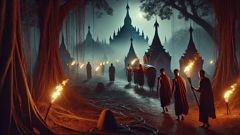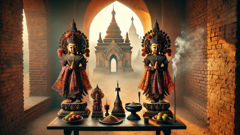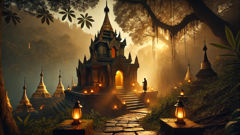Introduction
Under the ochre sky of Bagan, where the plain stretches like a breathing tapestry of brick stupas and tamarind trees, a story has whispered through generations and festival smoke. It is a story of two brothers born to princely blood, of laughter shared beneath banana fronds and the first cold of dawn spent practicing the archers' bow beside quiet ponds. The plain remembers them in the long shadow cast by temples at dusk, in offerings of rice and lotus carried by hands that learned the shape of their names long before any chronicler wrote them. Their lives were braided with the city's fate: princes with a future in every footstep, each destined to stand at court by the king's side. Yet the shape of destiny shifted like a reed in the Irrawaddy's current, and betrayal came from the least expected place. When justice twisted into rage and the king's ear was filled with poison-sweet words, those two brothers were condemned and executed — not for crimes they had committed, but for the fragile weight of royal suspicion. What the executioners thought would end a small scandal instead unsettled the heavens. Grief became thunder and grief became flame. From the wronged blood of the princes rose power, and the city learned a new kind of reverence. In time those two souls were called into the folk name of nat — protectors and possessors, spirits who would stand sentinel over Bagan's bricks, who would be propitiated by river-side fishermen and gilded by temple caretakers. This retelling seeks not only to recount the events of their lives and their deaths, but to illuminate how memory, ritual, and landscape intertwined to fashion the living cult of Mahagiri and Hnamadawgyi, shaping the rites of protection around spires and market stalls, and explaining why, to this day, the city keeps a place for them in the quiet rituals of dawn.
Blood and Brick: Childhood, Court, and the Poisoned Tongue
They were born in different seasons but to the same courtyard. Mahagiri came first, broad-shouldered and quiet, eyes like the river at twilight. Hnamadawgyi followed two years later, lighter of step and quick with a smile that could settle the temper of a household servant. Their mother, a woman of gentle lineage and devoted habit, taught them to fold cloth for offerings and to spare the old gardener an extra shrimp from the midday pot. Their father, a prince whose hand steadied the affairs of a province near the mountains, instilled in them a sense of duty to land and people; he taught them the names of the herbs that cured fever and the stories of kings who ruled with the measure of both steel and mercy. The palace where they were raised was a small world: latticed windows, carved teak doors, a courtyard pond where lotuses unfolded like small moons. In the court there were tapestries that told victories and losses in equal thread, and the brothers would trace the embroidered battles with callused fingers, trying always to see themselves among the woven heroes.

Between lessons of statecraft and ritual, they practiced the arts expected of princes. Mahagiri learned the steady concentration of archery, his posture exact and his breaths measured. Hnamadawgyi loved the drum and could weave a story with a single, low stroke; he could make a whole company of servants laugh or remember their dead with the same cadence. They were not united only by blood: they read the same passages aloud under oil lamps, they shared the same tasse of preserved mangoes, and they quarried laughter from each other like a pair of boys insisting the world was theirs to test. The palace servants would later recall how they walked among the temples at odd hours, barefoot on warm stone, and listened to the older monks chant for the dead. They asked questions a prince should not always ask: Why do kings fear what they do not know? When a court official raised an eyebrow at such curiosity, only their mother smiled. The brother's bond was a fragile, luminous cord, and the city of Bagan watched from its stupas as two lives tightened and then frayed.
Court life, however, is an ecosystem of favors and whispered debts. A small slight to a minister, a delayed tribute to a favored noble, a steward's stolen rice — any of these could be magnified into a quarrel of lineage and honor. Over years, envy congealed into rumor. Whispers began as small as the spider's foot and grew until they were heavy with meaning: the princes coveted the throne; they hatched plots in the night; they consorted with foreign visitors. A woman at court who owed a debt of fear to a rival spun a story about Hnamadawgyi's late-night visits to a shrine, adding the salt of innuendo. A steward who sought promotion whispered of Mahagiri's supposed comments on the king's counsel. The king, old and weary with the weight of many harvests and many betrayals, was a mirror to which these distortions were held. It did not take much for the reflection to become enough: a few chosen phrases, presented as fact and embroidered by rumor, and the scale of royal favor tilted.
One evening, under a sky the color of iron, men came to the brothers' pavilion. The official who led them read an edict of betrayal, his voice flat as a blade. Accusation fell like a net, precise and cruel. There was no trial as the men of those days understood it, only the swift execution of a verdict that preserved the illusion of order. The brothers, who had done wrong to none, were bound like harvest bundles and led across the courtyard to the place of punishment, where the city often turned its attention from devotion to spectacle. The execution was carried out with the cold economy of those accustomed to ending lives in the name of state; no poet chronicled the last words with the tenderness of friendship, and no scribe saved a whisper for history. The mother who had taught them the names of healing herbs collapsed into silence, and Bagan exhaled a long, stunned breath. For a time, the plain seemed hushed as if waiting for a winter that had not been announced. The injustice settled on the city like dust on brick.
But the plain remembers blood differently than stone does. When the priests laid hands on the brothers' bodies and the common people buried them in a grove beneath a tamarind, the earth there was not empty of story. People who passed that grove afterward would experience sudden wind, inexplicable lights, or the somber cry of a hawk at midnight. A child who wandered by with a broken toy returned home saying that two men had lifted him back onto the path and calmed his tears with words older than the monastery bells. Stories multiply when grief is unavenged. The brothers' deaths became seeds no farmer could bury: whispered dreams of the executed princes took root in the city's memory, and those dreams grew into the first ugly miracle — a night when a flare of unearthly light rose from the grove and the cocking of a spirit's laugh rolled over the plain. People brought offerings, simple things at first: fruit, a few coins, scraps of cloth. Then larger offerings came as priests and laypeople alike sought to understand whether misfortune could become guardian. The current that runs through the Irrawaddy carries more than water; it carries memory. Word of strange protections spread to the markets of Bagan: a boat whose captain left a bowl of rice under a tamarind tree returned unscathed from a journey that should have killed his crew. Crops in the fields nearest the grove that had once been neglected grew greener and healthier than others. In time the stories coalesced into worship: images were carved of two young men, one stern and watchful, the other quick-eyed and smiling; their features came to be recognized and invoked. In the shape of nat, the city's sorrow became form and function. The executed princes became guardians, and the city accepted the paradox that unjust death had produced a new kind of justice — an uncanny one that answered not to courts but to offerings, to incense, to the memory of wrongs that demand to be righted.
From Wronged Blood to Nat Power: Ritual, Memory, and the City Protected
The transformation from dead princes to potent nats did not happen overnight; it was a slow confluence of event, need, and cultural imagination. In Burma's spiritual geography, the nat is never purely malevolent or purely benign; it is a presence that requires recognition, propitiation, and negotiation. The people of Bagan, who had seen many forms of loss, recognized in the sudden signs around the grove something older than superstition — an answer to the ineffable injustice that had rent their city. Priests began to interpret the apparitions as omens. One monk, a man with a reputation for gentle insight, suggested that when a life ends without dignity, the world itself rebels, and the spirit refuses to dissolve into nothing. Instead, it stands between the living and the dead, taking on a role that balances the city's fortunes. Offerings increased: garlands of frangipani, bowls of rice, libations of toddy. The offerings were not simply gifts but acts of negotiation, an insistence that a wrong be known and honored so the wronged might be persuaded to guard rather than to rage. In response, miracles small and ineffable occurred. Boats that had been struck by sudden storms were guided back to shore by captains who later swore that two men had stood at the bow and calmed the waves. A plague that swept a neighboring village seemed to stumble and pass around one neighborhood near the grove as if an invisible wall diverted it. The stories of protection fed devotion, and devotion reinforced tales of protection in a feedback loop that made the brothers both human memory and divine presence.

As the cult of the brothers grew, it took on formal shape. Carved images and painted panels depicted Mahagiri as a steady figure, hand on scabbarded sword, eyes cast toward the horizon; Hnamadawgyi was shown with an upturned face, a drum at his hip and wind in his hair. The two figures were sometimes portrayed with traditional princely regalia, at other times dressed as common men, reminding worshippers of their dual nature: royal blood and popular guardianship. Rituals were established to honor them, combining older animist practices with the Buddhist frameworks that dominated Bagan. On certain days of the lunar calendar, villagers would process to the grove, carrying lacquered trays heavy with fruits and steaming rice, and leave incense to curl into the sky like small boats. A midwinter festival evolved where people re-enacted fragments of the brothers' lives — their generosity to the poor, their laughing competitions by the pond — followed by solemn offerings for protection in the coming year. Temple caretakers began to affix small images of the two brothers in shrines along the city's busiest streets. When merchants traveled, they would take a small likeness of Mahagiri for strength and a token of Hnamadawgyi for safe passage.
The brothers' presence did not, however, erase the memory of injustice. Their cult became a living complaint — a public reminder that the state could err and that wronged blood demanded a reckoning that transcended courts. Mothers who feared for their sons' futures told their children the story as both warning and comfort: warning that power could be treacherous, comfort that the wronged might yet stand between the innocent and misfortune. The city's laws and the people's customs braided together as the nat of the two brothers came to occupy a moral niche. Pilgrims from distant valleys arrived not only to pay homage but to see whether the guardianship of the princes would touch their own affairs. Some reported dreams in which the brothers appeared and spoke in marsh-quiet voices, offering counsel about the sway of envy and the stubbornness of truth. Others felt a sudden lightness of spirit upon visiting the grove, as if a burden they had carried for years had been placed on a stone and left there.
Over generations, the iconography associated with the brothers absorbed local symbols. A fisherman painted a small boat at the feet of Hnamadawgyi in gratitude for his survival of a storm; a farmer carved Mahagiri's image into a plow handle after his fields survived an unexpected flood. These personal acts of devotion stitched the brothers' presence into the daily life of Bagan. They became, in effect, guardians of both big things — the city's harvests, its people, and its sacred precincts — and small things: the breath of a crying infant, the safe return of a merchant, the steadying of a heart doubting a ruler. Their names were sung in laments and in lullabies; temple murals that once told only the deeds of famous kings began to include scenes of a stern prince calming a market dispute and a smiling younger brother mending a broken boat. The memory of their execution persisted as an embittered undercurrent, a cautionary tale about the peril of trusting court rumor, but it was tempered by the practical, reciprocal relationship that people had with their protectors.
In modern times, when Bagan's skyline is dotted with tourist boats and cameras click like rain, the cult of Mahagiri and Hnamadawgyi persists. Caretakers still sweep the base of the tamarind where they were buried; offerings still appear where morning light stains brick. Though the polity has changed and kings no longer issue edicts from palace balconies, the human impulse to redress injustice through ritual has not. Contemporary devotees and curious visitors alike find in the brothers' story a layered lesson: that even the most unjust death can, through remembrance and negotiated worship, become a safeguard against future sorrow. Their legend endures because it answers to something elemental in human communities: the need to transform pain into protection, to make a public account of private loss, and to bind the living to the dead with acts of protection and reciprocity. People still whisper their names into the smoke of incense, and Bagan, with her spires and her plain, keeps its own counsel while the two princes watch from the shadowed places where history and devotion meet.
Conclusion
To walk the plain of Bagan is to walk amid memory: bricks warmed by sun, trees that have grown around old sorrows, and shrines that keep small, private conversations with the dead. The tale of Mahagiri and Hnamadawgyi endures because it occupies the space where human law failed and spiritual practice answered. It is a story about the vulnerability of trust, the cruelty of misapplied power, and the astonishing capacity of communities to reweave meaning out of tragedy. Through offerings at a tamarind grove, through painted faces on temple panels, through festivals and whispered prayers, the brothers remain present: guardians not by right of crown but by the insistence of a city that would not let their names be erased. Every gilded offering and every returned boat is a small chapter in a legend that binds past with present. Bagan keeps them, and in so doing the city keeps a living reminder that when systems fail, people will find other ways to protect what they hold dear; and sometimes protection comes from the most unexpected place — the wronged and executed rising again, not for vengeance, but to watch, to hold, and to shelter a city that once failed them.


















